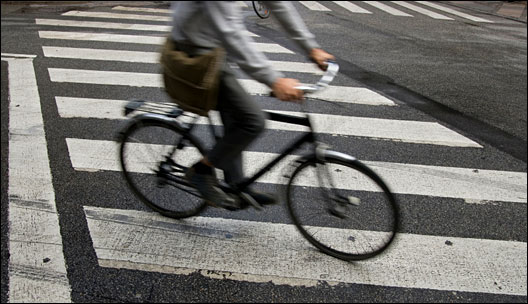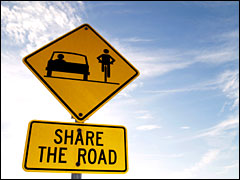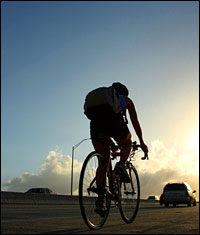
Ever glance enviously at the cyclists whizzing past while you’re stuck in traffic? Joining ’em is easy — and it doesn’t have to involve full-body spandex. The health benefits of biking to work are plenty, from helmet hair a svelte physique to breathing fewer air pollutants than those stuck in cars. Regular bikers live longer and are less likely to get depressed than non-bikers, boasts the Chelsea Green Guide on biking to work. And with fuel prices showing no sign of coming down, you can save serious bling on gas — plus, there’s that teeny detail of cutting your carbon emissions.
Employers are wising up to the perks of bike commuting, too, as two-wheeling workers are more productive and don’t need parking spaces. Google gave 2,000 bikes to employees in Europe, the Middle East, and Africa last spring, and the lucky folks at New Belgium Brewing Co. receive a bike after a year of service. In addition to bike storage and showers, Seattle’s Vulcan gives cyclists money for a cab if they leave after sunset — not too shabby!
So what’s not to love? Maybe the fear of getting doored, but don’t let that keep you off the streets. Biking is safer than you think — some claim it’s even safer than driving.
How do you avoid the perils of the open road and arrive at the office, soy latté intact? Here’s how to start.
Level One: The Baby Steps
Chart your course. If you can, get a bike map for your area so you can familiarize yourself with bike-friendly streets — a quick Google search turned up maps for all sorts of cities, from Seattle to Tucson. You can also check out sites like Map My Ride, which help you do just that, as well as viewing routes in your area that other bikers use. While you’re poking around, sign the petition asking Google Maps to add a “bike there” option to their public transportation and driving directions.

‘Nuff said.
Get to the route of it. When planning your route, pick a road parallel to the main drag to avoid traffic, and be uber-cautious around intersections — over half of bike/car crashes happen there. (Your city might even have a map of historically dangerous intersections [PDF] so you can be especially careful or avoid them altogether.) If you live too far from work to bike the whole way, look for ways to combine your ride with a commuter train, subway, bus, or carpool. For further advice, scan your office at 9 a.m. for the sweatiest co-workers and wring suggestions out of them.
Level Two: The Next Steps
Get in gear. If you’ve got an inclination toward perspiration and are in the market for new wheels, commuter bikes have a higher comfort factor than mountain bikes. Whether your rig is new or old, pump up your tires and check your brakes, or get a full tune-up at a local bike shop. Bike gadgets are endless, and what you consider a necessity will vary, but you definitely need lights and reflectors to be legal. You may also want fenders to keep your wheels from spraying muck on your clothes, panniers or a rack to tote stuff, a filter mask for bad air, and even a cycling cap to salvage your ‘do under your helmet (you do have a good helmet, right?). A chain guard will protect your threads if you don’t rock the single-rolled-pantleg look. And gloves, layers, and raingear will be essential come winter.

Riding off into the sunset.
Give it a whirl. If you’re an inexperienced cyclist or it’s been a while, take a safety course before heading out, or find a bike coalition or bicycle-advocacy organization in your area and ride with them. When you’re ready, do a trial run to work on the weekend, keeping in mind that it’ll be busier during weekday rush hour — and see if a wheely nice coworker is willing to come along.
Once in a biketime. Pick one day a week to bike to work, and go for it, giving yourself plenty of time. Find out if your building has a bike room and make sure you have a good lock. Same for showers — your building may have some, or a nearby gym might be willing to strike a deal for occasional use. A shower might not even be necessary, though; for those with shorter commutes, a light washcloth wipe-down and a fresh swipe of deodorant may do the trick.
Level Three: The Big Step
Ride every day. You did it! You figured out how to get to work on a bike, and now you want to do it every day. Use this calculator to estimate your gas and CO2 savings, which can really add up. Then give yourself a pat on your ever-more-muscly back! And now that you’re a bikeophile, advocate to make your community more bike-friendly.
Resources
Advice, safety tips, and info
Urban Bikers’ Tricks & Tips
Chelsea Green Guide: Biking to Work
Transportation Alternatives Magazine
Why biking is safer than you think
Bike crash facts
Avoiding the most common bike/car collisions
Advocating for a more bike-friendly community
Video on the basics of commuting by bike
Biking advice from Umbra in the Grist archives
On bike commuting
On bike commuting, again
On exerting yourself in traffic
On the impacts of biking
On biking in a skirt
On transporting coffee by bike
On hauling goods by bike
Biking coalitions
Alliance for Biking and Walking
Bikes Belong
League of American Bicyclists
Adventure Cycling Association
Critical Mass
Bike for All


